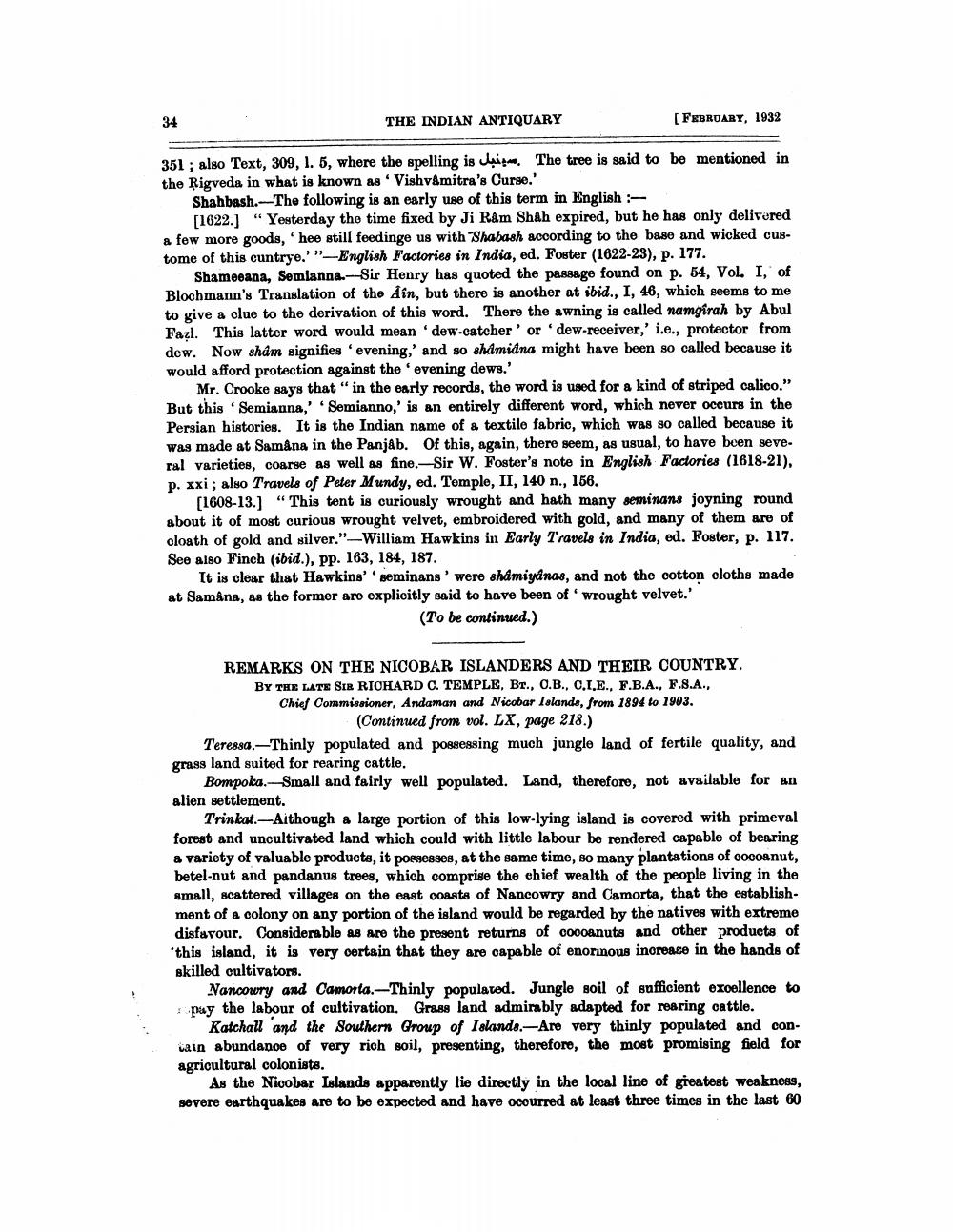________________
34
THE INDIAN ANTIQUARY
[ FEBRUARY, 1932
351 ; also Text, 309, 1. 5, where the spelling is his. The tree is said to be mentioned in the Rigveda in what is known as VishvAmitra's Curse.'
Shahbash. The following is an early use of this term in English
[1622.] "Yesterday the time fixed by Ji Ram Shah expired, but he has only delivered a few more goods, 'hee still feedinge us with Shabash according to the base and wicked custome of this cuntrye.' "-English Factories in India, ed. Foster (1622-23), p. 177.
Shamovana, Semianna-Sir Henry has quoted the passage found on p. 54, Vol. I, of Blochmann's Translation of the Rin, but there is another at ibid., I, 46, which seems to me to give a clue to the derivation of this word. There the awning is called namgirah by Abul Fazl. This latter word would mean 'dew-catcher' or 'dew-receiver,' i.e., protector from dew. Now sham signifies evening,' and so shámiána might have been so called because it would afford protection against the evening dews.'
Mr. Crooke says that " in the early records, the word is used for a kind of striped calico." But this Semianna,' Semianno,' is an entirely different word, which never occurs in the Persian histories. It is the Indian name of a textile fabric, which was so called because it was made at Samana in the Panjab. Of this, again, there seem, as usual, to have been seve. ral varieties, coarse as well as fine.- Sir W. Foster's note in English Factories (1618-21), p. xxi; also Travels of Peter Mundy, ed. Temple, II, 140 n., 156.
(1608-13.) “This tent is curiously wrought and hath many seminans joyning round about it of most curious wrought velvet, embroidered with gold, and many of them are of cloath of gold and silver."-William Hawkins in Early Travels in India, ed. Foster, p. 117. See also Finch (ibid.), pp. 163, 184, 187.
It is clear that Hawkins' seminans' were shamiyánas, and not the cotton cloths made at Samana, as the former are explicitly said to have been of wrought velvet.'
(To be continued.)
REMARKS ON THE NICOBAR ISLANDERS AND THEIR COUNTRY. BY THE LATE SIR RICHARD C. TEMPLE, Bt., O.B., C.L.E., F.B.A., F.S.A., Chief Commissioner, Andaman and Nicobar Islands, from 1894 to 1903.
(Continued from vol. LX, page 218.) Teressa.- Thinly populated and possessing much jungle land of fertile quality, and grass land suited for rearing cattle.
Bompoka.Small and fairly well populated. Land, therefore, not available for an alien settlement.
Trinkat.-Although a large portion of this low-lying island is covered with primeval forest and uncultivated land which could with little labour be rendered capable of bearing & variety of valuable products, it possesses, at the same time, so many plantations of cocoanut, betel nut and pandanus trees, which comprise the chief wealth of the people living in the small, scattered villages on the east coasts of Nancowry and Camorta, that the establishment of a colony on any portion of the island would be regarded by the natives with extreme disfavour. Considerable as are the present returns of coooanuts and other products of 'this island, it is very certain that they are capable of enormous increase in the hands of skilled cultivators.
Nancowry and Camorta.-Thinly populated. Jungle soil of sufficient exoellence to pay the labour of cultivation. Grass land admirably adapted for rearing cattle.
Katchall and the Southern Group of Islands.-Are very thinly populated and convain abundanoe of very rich soil, presenting, therefore, the most promising field for agricultural colonists.
As the Nicobar Islands apparently lie directly in the local line of gieatest weakness, severe earthquakes are to be expected and have ocourred at least three times in the last 60




